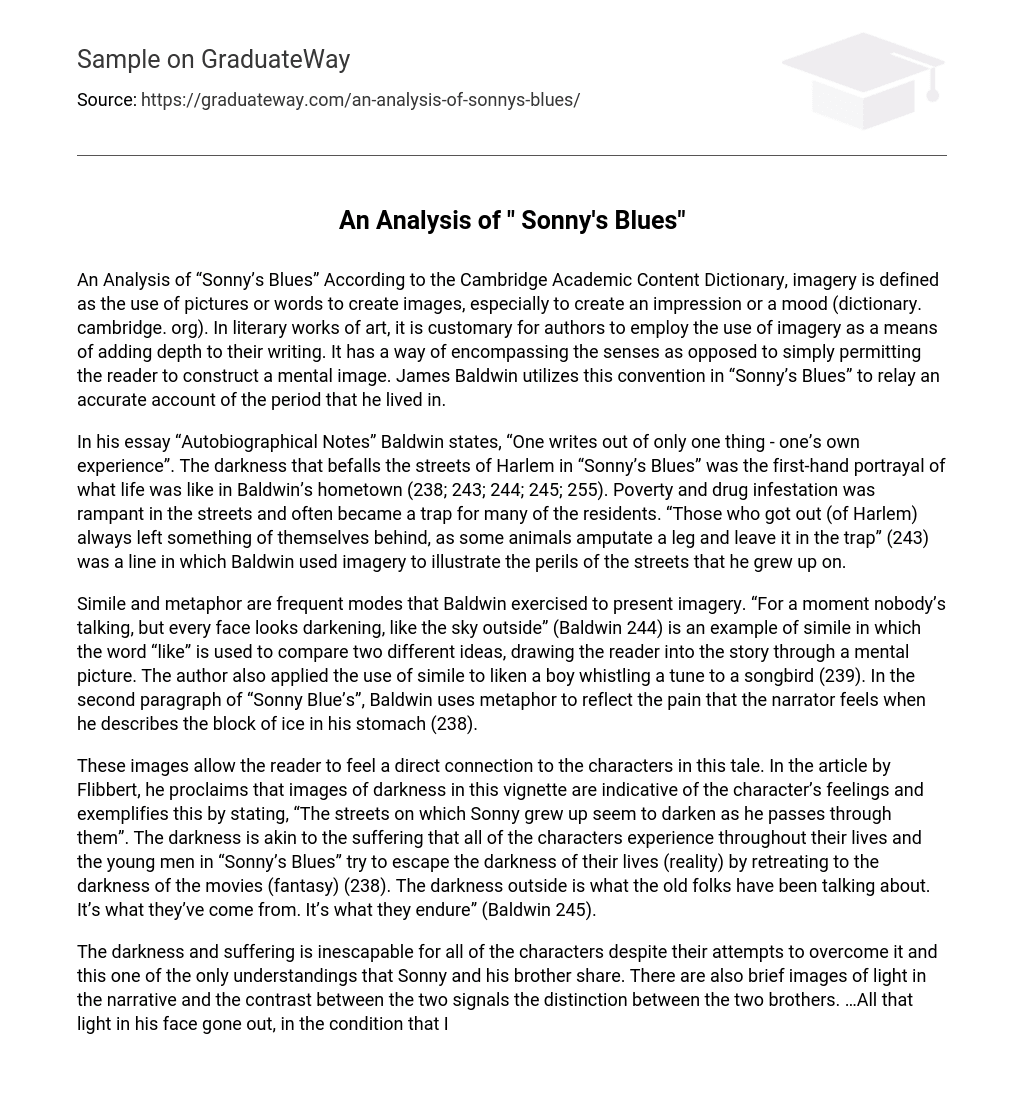An Analysis of “Sonny’s Blues” According to the Cambridge Academic Content Dictionary, imagery is defined as the use of pictures or words to create images, especially to create an impression or a mood (dictionary. cambridge. org). In literary works of art, it is customary for authors to employ the use of imagery as a means of adding depth to their writing. It has a way of encompassing the senses as opposed to simply permitting the reader to construct a mental image. James Baldwin utilizes this convention in “Sonny’s Blues” to relay an accurate account of the period that he lived in.
In his essay “Autobiographical Notes” Baldwin states, “One writes out of only one thing – one’s own experience”. The darkness that befalls the streets of Harlem in “Sonny’s Blues” was the first-hand portrayal of what life was like in Baldwin’s hometown (238; 243; 244; 245; 255). Poverty and drug infestation was rampant in the streets and often became a trap for many of the residents. “Those who got out (of Harlem) always left something of themselves behind, as some animals amputate a leg and leave it in the trap” (243) was a line in which Baldwin used imagery to illustrate the perils of the streets that he grew up on.
Simile and metaphor are frequent modes that Baldwin exercised to present imagery. “For a moment nobody’s talking, but every face looks darkening, like the sky outside” (Baldwin 244) is an example of simile in which the word “like” is used to compare two different ideas, drawing the reader into the story through a mental picture. The author also applied the use of simile to liken a boy whistling a tune to a songbird (239). In the second paragraph of “Sonny Blue’s”, Baldwin uses metaphor to reflect the pain that the narrator feels when he describes the block of ice in his stomach (238).
These images allow the reader to feel a direct connection to the characters in this tale. In the article by Flibbert, he proclaims that images of darkness in this vignette are indicative of the character’s feelings and exemplifies this by stating, “The streets on which Sonny grew up seem to darken as he passes through them”. The darkness is akin to the suffering that all of the characters experience throughout their lives and the young men in “Sonny’s Blues” try to escape the darkness of their lives (reality) by retreating to the darkness of the movies (fantasy) (238). The darkness outside is what the old folks have been talking about. It’s what they’ve come from. It’s what they endure” (Baldwin 245).
The darkness and suffering is inescapable for all of the characters despite their attempts to overcome it and this one of the only understandings that Sonny and his brother share. There are also brief images of light in the narrative and the contrast between the two signals the distinction between the two brothers. …All that light in his face gone out, in the condition that I’d already seen so many others” (Baldwin 238) is how the narrator described Sonny’s descent to darkness. The light is representative of the narrator’s ability to escape the pitfalls of the streets while the darkness is symbolic of Sonny’s struggles with drug addiction. Additionally, the darkness and light in the story that showed on the faces of the children denote a loss of innocence as the children grow away from the light at home toward the darkness outside (Baldwin 244).
The use of imagery is instrumental to conveying a semblance of what the author is feeling to the reader. At the time of publication, “Sonny’s Blues” was Baldwin’s way to reflect on the racial identity problems that he and all African Americans faced. Furthermore, Sonny’s character used a creative outlet (Blues) to escape the darkness just as Baldwin used his writing. In an essence, Baldwin and Sonny are one and the same.
Works Cited
Baldwin, James. “Sonny’s Blues” Going to Meet the Man. New York: The Dial Press, 1965. Web. 10 September 2012 Flibbert, Joseph. “Sonny’s Blues: Overview short story 1957”. Reference Guide to Short Fiction. Ed. Noelle Watson. Detroit: St. James Press, 1994. Literature Resource Center. Web. 10 September 2012 “Imagery”. Cambridge Academic Content Dictionary. Cambridge University Press. Web. 7 October 2012 “James Baldwin”. Gay & Lesbian Biography. Ed. Michael Tyrkus and Michael Bronski. Detroit: St. James Press, 1997. Literature Resource Center. Web. 10 September 2012





